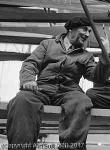Naum Gabo
Naum Gabo
Stil: Kinetic Art;
Mjesto: Bryansk
Rođen: 1890
Smrt: 1977
Biografija:
Naum Gabo, born Naum Neemia Pevsner (Hebrew: נחום נחמיה פבזנר), was an influential sculptor, theorist, and key figure in Russia's post-Revolution avant-garde and the subsequent development of twentieth-century sculpture. His work combined geometric abstraction with a dynamic organization of form in small reliefs and constructions, monumental public sculpture and pioneering kinetic works that assimilated new materials such as nylon, wire, lucite and semi-transparent materials, glass and metal. Responding to the scientific and political revolutions of his age, Gabo led an eventful and peripatetic life, moving to Berlin, Paris, Oslo, Moscow, London, and finally the United States, and within the circles of the major avant-garde movements of the day, including Cubism, Futurism, Constructivism, the Bauhaus, de Stijl and the Abstraction-Création group. Two preoccupations, unique to Gabo, were his interest in representing negative space—"released from any closed volume" or mass—and time. He famously explored the former idea in his Linear Construction works (1942-1971)—used nylon filament to create voids or interior spaces as "concrete" as the elements of solid mass—and the latter in his pioneering work, Kinetic Sculpture (Standing Waves) (1920), often considered the first kinetic work of art.
Gabo elaborated many of his ideas in the Constructivist Realistic Manifesto, which he issued with his brother, sculptor Antoine Pevsner as a handbill accompanying their 1920 open-air exhibition in Moscow. In it, he sought to move past Cubism and Futurism, renouncing what he saw as the static, decorative use of color, line, volume and solid mass in favor of a new element he called "the kinetic rhythms (…) the basic forms of our perception of real time." Gabo held a utopian belief in the power of sculpture—specifically abstract, Constructivist sculpture—to express human experience and spirituality in tune with modernity, social progress, and advances in science and technology. After working on a smaller scale in England during the war years (1936-1946), Gabo moved to the United States, where he received several public sculpture commissions, only some of which he completed. These include Constructie, an 81-foot commemorative monument in front of the Bijenkorf Department Store (1954, unveiled in 1957) in Rotterdam, and Revolving Torsion, a large fountain outside St Thomas Hospital in London. The Tate Gallery, London held a major retrospective of Gabo's work in 1966 and holds many key works in its collection, as do the Museum of Modern Art and Guggenheim Museum in New York.
Gabo grew up in a Jewish family of six children in the provincial Russian town of Bryansk, where his father owned a factory. His older brother was fellow Constructivist artist Antoine Pevsner; Gabo changed his name to avoid confusion with him. Gabo was a fluent speaker and writer in German, French, and English in addition to his native Russian. His command of several languages contributed greatly to his mobility during his career. “As in thought, so in feeling, a vague communication is no communication at all," Gabo once remarked.
After school in Kursk, Gabo entered Munich University in 1910, first studying medicine, then the natural sciences, and attended art history lectures by Heinrich Wölfflin. In 1912 Gabo transferred to an engineering school in Munich where he discovered abstract art and met Wassily Kandinsky and in 1913-14 joined his brother Antoine (who by then was an established painter) in Paris. Gabo's engineering training was key to the development of his sculptural work that often used machined elements. During this time he won acclamations by many critics and awards like the $1000 Mr and Mrs Frank G. Logan Art Institute Prize at the annual Chicago and Vicinity exhibition of 1954.
After the outbreak of war, Gabo moved first to Copenhagen then Oslo with his older brother Alexei, making his first constructions under the name Naum Gabo in 1915. These earliest constructions originally in cardboard or wood were figurative such as the Head No.2 in the Tate collection. He moved back to Russia in 1917, to become involved in politics and art, spending five years in Moscow with his brother Antoine.
Gabo contributed to the Agit-prop open air exhibitions and taught at 'VKhUTEMAS' the Higher Art and Technical Workshop, with Tatlin, Kandinsky and Rodchenko. During this period the reliefs and construction became more geometric and Gabo began to experiment with kinetic sculpture though the majority of the work was lost or destroyed. Gabo's designs had become increasingly monumental but there was little opportunity to apply them; as he commented, "It was the height of civil war, hunger and disorder in Russia. To find any part of machinery … was next to impossible". Gabo wrote and issued jointly with Antoine Pevsner in August 1920 a "Realistic Manifesto" proclaiming the tenets of pure Constructivism – the first time that the term was used. In the manifesto Gabo criticized Cubism and Futurism as not becoming fully abstract arts and stated that the spiritual experience was the root of artistic production. Gabo and Pevsner promoted the manifesto by staging an exhibition on a bandstand on Tverskoy Boulevard in Moscow and posted the manifesto on hoardings around the city.
More...
Wikipedia link: Click Here












